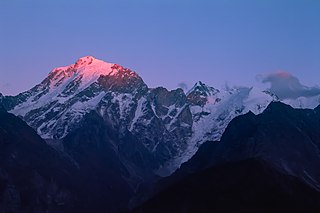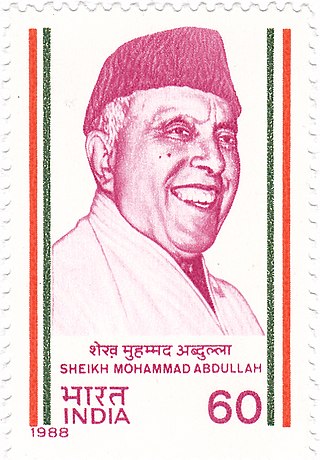
Srinagar is the largest city and the summer capital of Jammu and Kashmir, India. It lies in the Kashmir Valley on the banks of the Jhelum River, a tributary of the Indus, and Dal and Anchar lakes. The city is known for its natural environment, gardens, waterfronts and houseboats. It is known for traditional Kashmiri handicrafts like the Kashmir shawl, and also dried fruits. It is the 31st-most populous city in India, the northernmost city in India to have over one million people, and the second-largest metropolitan area in the Himalayas.

India is a federal union comprising 28 states and 8 union territories, with a total of 36 entities. The states and union territories are further subdivided into districts and smaller administrative divisions.

The history of Kashmir is intertwined with the history of the broader Indian subcontinent in South Asia with minor influences from the surrounding regions of Central Asia and East Asia. Historically, Kashmir referred to only the Kashmir Valley in Jammu and Kashmir, India. Today, it denotes a larger area that includes the Indian-administered union territories of Jammu and Kashmir and Ladakh, the Pakistan-administered territories of Azad Kashmir and Gilgit-Baltistan, and the Chinese-administered regions of Aksai Chin and the Trans-Karakoram Tract.

The Indo-Pakistani War of 1947–1948, or the First Kashmir War, was a war fought between India and Pakistan over the princely state of Jammu and Kashmir from 1947 to 1948. It was the first of four Indo-Pakistani wars between the two newly independent nations. Pakistan precipitated the war a few weeks after its independence by launching tribal lashkar (militias) from Waziristan, in an effort to capture Kashmir and to preempt the possibility of its ruler joining India. The inconclusive result of the war still affects the geopolitics of both countries.

The Jammu & Kashmir National Conference (JKNC) is a regional political party in the Indian union territories of Jammu and Kashmir and Ladakh. Founded as the All Jammu and Kashmir Muslim Conference by Sheikh Abdullah and Chaudhry Ghulam Abbas in 1932 in the princely state of Jammu and Kashmir, the organisation renamed itself to "National Conference" in 1939 in order to represent all the people of the state. It supported the accession of the princely state to India in 1947. Prior to that, in 1941, a group led by Ghulam Abbas broke off from the National Conference and revived the old Muslim Conference. The revived Muslim Conference supported the accession of the princely state to Pakistan and led the movement for Azad Kashmir.

North India is a loosely defined region consisting of the northern part of India. The dominant geographical features of North India are the Indo-Gangetic Plain and the Himalayas, which demarcate the region from the Tibetan Plateau and Central Asia.

Sheikh Mohammad Abdullah was an Indian politician who played a central role in the politics of Jammu and Kashmir. Abdullah was the founding leader of the All Jammu and Kashmir Muslim Conference and the 1st elected Prime Minister of Jammu and Kashmir after its accession to India. He agitated against the rule of the Maharaja Hari Singh and urged self-rule for Kashmir. He served as the 1st elected Prime Minister of the Princely State of Jammu and Kashmir and was later jailed and exiled. He was dismissed from the position of Prime Ministership on 8 August 1953 and Bakshi Ghulam Mohammad was appointed the new Prime Minister. The expressions 'Sadr-i-Riyasat' and 'Prime Minister' were replaced with the terms 'Governor' and 'Chief Minister' in 1965. Sheikh Abdullah again became the Chief Minister of the state following the 1974 Indira-Sheikh accord and remained in the top slot till his death on 8 September 1982.

The Kashmir conflict is a territorial conflict over the Kashmir region, primarily between India and Pakistan and also between China and India in northeastern portion of the region. The conflict started after the partition of India in 1947 as both India and Pakistan claimed the entirety of the former princely state of Jammu and Kashmir. It is a dispute over the region that escalated into three wars between India and Pakistan and several other armed skirmishes. India controls approximately 55% of the land area of the region that includes Jammu, the Kashmir Valley, most of Ladakh, the Siachen Glacier, and 70% of its population; Pakistan controls approximately 30% of the land area that includes Azad Kashmir and Gilgit-Baltistan; and China controls the remaining 15% of the land area that includes the Aksai Chin region, the mostly uninhabited Trans-Karakoram Tract, and part of the Demchok sector.

Article 370 of the Indian constitution gave special status to Jammu and Kashmir, a region located in the northern part of Indian subcontinent and part of the larger region of Kashmir which has been the subject of a dispute between India, Pakistan and China since 1947. Jammu and Kashmir was administered by India as a state from 1952 to 31 October 2019, and Article 370 conferred on it the power to have a separate constitution, a state flag, and autonomy of internal administration.

The Bakarwal are a nomadic ethnic group, who along with Gujjars are listed as Scheduled Tribes in the Indian Union Territory of Jammu and Kashmir and Ladakh since 1991. Gujjar Bakerwal is the largest Muslim tribe in India and third largest ethnic community in the Indian part of Jammu and Kashmir.

Karan Singh is an Indian politician and philosopher. He is the king of Jammu and Kashmir. He was the prince regent of Jammu and Kashmir until 1952. From 1952 to 1965 he was the Sadr-i-Riyasat (President) of the state of Jammu and Kashmir in the Republic of India. He is the chairperson trustee of the Dharmarth Trust of Jammu and Kashmir which maintains 175 temples in north India and works in other areas such as historical preservation.

Narinder Nath Vohra, popularly referred as N. N. Vohra, is a retired 1959 batch Indian Administrative Service (IAS) officer of Punjab cadre who was the 12th governor of the Indian state of Jammu and Kashmir. He was the first civilian governor of Jammu and Kashmir in eighteen years after Jagmohan.

A union territory is a type of administrative division in the Republic of India. Unlike the states of India, which have their own governments, union territories are federal territories governed, in part or in whole, by the Union Government of India. There are currently eight union territories in India, namely Andaman and Nicobar Islands, Chandigarh, Dadra and Nagar Haveli and Daman and Diu, Delhi, Jammu and Kashmir, Ladakh, Lakshadweep and Puducherry.
Gilgit Baltistan is an administrative territory of Pakistan that borders the province of Khyber Pakhtunkhwa to the west, Azad Kashmir to the southwest, Wakhan Corridor of Afghanistan to the northwest, the Xinjiang Uyghur Autonomous Region of China to the north, and the Indian administrated region of Jammu and Kashmir to the south and southeast. The region is disputed and claimed by India as part of the Jammu and Kashmir state.

The Jammu–Sialkot line was a 43 km (27 mi) broad gauge branch of the North Western State Railway from Wazirabad Junction, Punjab, to Jammu, passing through the Sialkot Junction. The section from Sialkot to Jammu (Tawi) was 27 miles long, partly in the British Indian province of Punjab and partly in the princely state of Jammu and Kashmir Built in 1890 during the reign of Maharaja Pratap Singh, it was the first railway line in the state of Jammu and Kashmir.
Ved Kumari Ghai is a sanskrit scholar from Jammu City, Jammu and Kashmir, India. She was head of the Sanskrit department in Jammu University.

Jammu is the winter capital of the Indian union territory of Jammu and Kashmir. It is the headquarters and the largest city in Jammu district of the union territory. Lying on the banks of the river Tawi, the city of Jammu, with an area of 240 km2 (93 sq mi), is surrounded by the Himalayas in the north and the northern-plains in the south. Jammu is the second most populous city of the union territory. Three battles have been fought in the city: first by the founder Raja Mal Dev against Timur in Battle of Jammu (1399), second by Sardar Bhag Singh against Mughal army in Battle of Jammu (1712) and the third by Mian Dido & Maharaja Gulab Singh against Ranjit Singh's army in Battle of Jammu (1808).
Rajendra Tiku, is an Indian sculptor and art teacher known for his outdoor stone sculptures. He was honoured by the Government of India, in 2013, by bestowing on him the Padma Shri, the fourth highest civilian award, for his contributions to the field of art.
Sangeeta Gupta, a retired Chief Commissioner of Income Tax, is an Indian abstract artist, poet and filmmaker. She is the first woman who qualified Civil Services from her district in Uttar Pradesh, India. She is an officer of 1984 batch IRS. Her artistic journey so far consist of 35 solo exhibitions of paintings, 25 published books including Fourteen anthologies of poems in Hindi and six in English. From her collection of poems, 10 books are translated into German, Greek, Mandarin, English, Bangla, Dogri, Tamil and Urdu. She has also directed, scripted and shot 30 documentary films, 6 of which are in the collection of Library of Congress, US. Song of the Cosmos is her creative biography.


















